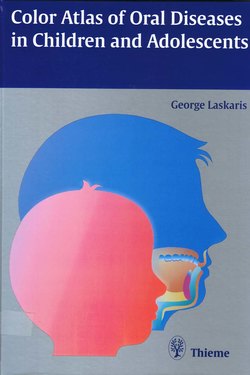Читать книгу Color Atlas of Oral Diseases in Children and Adolescents - George Laskaris - Страница 12
На сайте Литреса книга снята с продажи.
Оглавление3 Mechanical and Electrical Injuries
Traumatic Ulcer
Definition
• Traumatic ulcer is a form of acute or chronic mechanical injury to the oral mucosa leading to loss of all epithelial layers.
Etiology
• It can result from a sharp or broken tooth, an ill-fitting amalgam restoration, orthodontic materials, accidental biting during mastication, sharp foreign bodies and clumsy use of dental instruments.
Occurrence in children
• Common.
Localization
• Tongue, buccal mucosa, lips, gingiva, mucobuccal fold.
Clinical features
• Traumatic ulcer usually presents as a single, ill-defined painful ulceration, with a smooth surface and erythematous or whitish borders (Figs. 3.1–3.4).
• The size may range from a few millimeters to several centimeters.
• There is a close relationship between the ulcer and the irritating cause.
• The ulcer may persist for a long time, but usually heals within 7–10 days after elimination of the cause.
• The diagnosis is based on the history and clinical features.
Laboratory tests
• Biopsy and histopathological examination only to rule out malignancies or other specific ulcerations.
Differential diagnosis
• Aphthous ulcers
• Necrotizing ulcerative gingivitis and stomatitis
• Eosinophilic ulcer
• Squamous-cell carcinoma
• Necrotizing sialadenometaplasia
Treatment
• Removal of the etiological factors.
• Symptomatic.
Bite Injuries
Definition
• Bite injuries are common lesions caused by chronic manipulation of the oral mucosa.
Etiology
• Continuous mild chewing, sharp teeth.
• In children under stress, or in those with psychological problems.
Occurrence in children
• Common.
Localization
• Lateral borders and tip of the tongue.
• Buccal mucosa, lower lip.
Clinical features
• The lesions usually present as macerated, irregular thickened, shredded, painless, white areas with characteristic desquamation of the affected epithelium (Figs. 3.5–3.8).
• Superficial erosions may also be seen.
• The lesions may be unilateral or bilateral, localized or diffuse.
• Diagnosis is based on the history and the clinical features.
Differential diagnosis
• Candidiasis
• White sponge nevus
• Leukoedema
• Hairy leukoplakia
• Lichen planus
• Leukoplakia
Treatment
• No treatment is required.
• Elimination of the habit.
Fig. 3.1 Traumatic ulcer of the buccal mucosa
Fig. 3.2 Traumatic ulcer of the tongue
Fig. 3.3 Traumatic ulcer of the gingiva (first premolar area)
Fig. 3.4 Traumatic ulcer of the upper alveolar mucosa in an infant
Fig. 3.5 Chronic biting of the tip of the tongue
Fig. 3.6 Chronic biting of the right lateral border of the tongue
Fig. 3.7 Chronic biting, resulting in a tumor-like lesion on the left lateral border of the tongue
Fig. 3.8 Chronic mild biting, resulting in a linear mucosal elevation along the occlusal line of the buccal mucosa
Self-Induced Injury
Definition
• Self-induced injury, or factitious trauma, is deliberate injury to the oral mucosa by the patients themselves.
Etiology
• In children with serious psychological problems who want to attract attention, or are mentally retarded.
• The trauma is usually inflicted through repeated biting of the fingernails, or with toothpicks, pencils, knives, and other hard, sharp objects.
Occurrence in children
• Relatively common.
Localization
• Tongue, gingiva, lips, buccal mucosa.
Clinical features
• The lesions vary from erythema, to a deep, ill-defined, painful oral ulceration with sharp borders (Figs. 3.9–3.11).
• Similar lesions may be seen on the skin (Fig. 3.12).
• The lesions are slow to heal, due to perpetuation of the injury by the patient.
• The diagnosis is based on the history and on clinical suspicion.
• The patients usually deny that they produce the lesions themselves.
Laboratory tests
• Biopsy and histopathological examination only to rule out other specific lesions.
Differential diagnosis
• Traumatic ulcer from other causes
• Aphthous ulcers
• Tuberculosis
• Syphilis
• Neoplasms
Treatment
• Discontinuation of the habit.
• Collaboration with a pediatrician and a psychologist.
Electrical Burns
Definition
• Electrical burns are collectively the most common burns seen in the oral cavity in children.
Etiology
• Biting into an electric cable, or inappropriate use of a faulty electrical appliance.
Occurrence in children
• Fairly common.
• Most electrical burns occur in children below six years of age.
Localization
• Lips, commissures, and perioral areas are most frequently affected.
• Tongue, gingiva, alveolar ridge, floor of the mouth and mucobuccal folds may also be less frequently affected.
Clinical features
• Clinically, electrical burns in the oral mucosa present as a painless, white-gray, coagulated lesion with no bleeding and surrounded by a narrow rim of erythema. Progressively, the white-gray surface evolves into brown-black charred tissues and finally sloughs, leaving a deep ulcer that may hemorrhage (Fig. 3.13).
• The adjacent teeth may become non-vital.
• Scarring and microstomia are common complications.
• The diagnosis is based on the history and the clinical features.
Differential diagnosis
• Traumatic ulcers
• Severe thermal burn
• Noma
Treatment
• It is supportive.
• Surgical reconstruction may be necessary in severe cases.
Fig. 3.9 Two minor factitious injuries on the dorsum of the tongue
Fig. 3.10 Large factitious ulcer on the dorsum of the tongue
Fig. 3.11 Huge factitious ulcers on the tongue and the lower lip in a young boy with serious psychological problems
Fig. 3.12 Huge factitious ulcer on the skin in a young girl with serious psychological problems
Other Lesions
Various lesions caused by mechanical injury are frequently observed in children’s oral mucosa. Hyperplasia after continuous mild injury caused by orthodontic or prosthetic materials, traumatic hematoma, traumatic hemorrhagic bullae, erythema, and small erosions produced by the toothbrush are some of the most frequent oral lesions that may cause diagnostic problems (Fig. 3.14).
In such cases, the diagnosis is based on a detailed history, which helps to exclude oral lesions due to other causes, and biopsy and histological examination may rarely be necessary.
Fig. 3.13 Electrical bum on the lower lip and left commissure
Fig. 3.14 Traumatic hematoma of the upper lip
